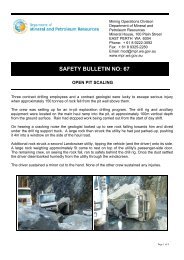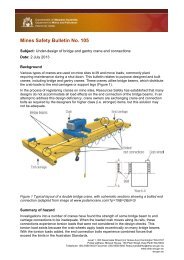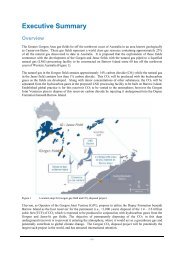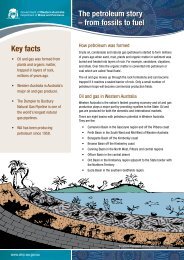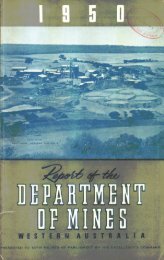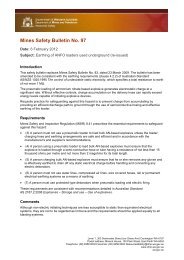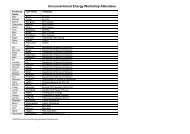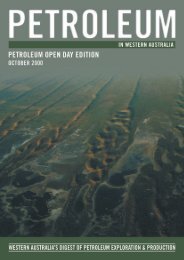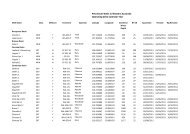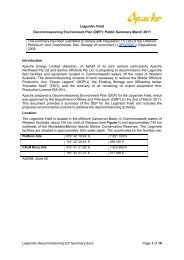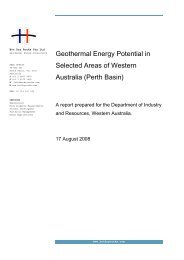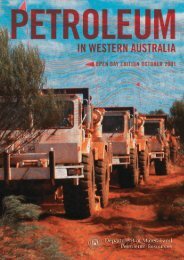Area Summary L12-14 - Department of Mines and Petroleum
Area Summary L12-14 - Department of Mines and Petroleum
Area Summary L12-14 - Department of Mines and Petroleum
You also want an ePaper? Increase the reach of your titles
YUMPU automatically turns print PDFs into web optimized ePapers that Google loves.
<strong>of</strong> poorly sorted feldspathic s<strong>and</strong>stone with subordinate<br />
intervals <strong>of</strong> conglomerate, siltstone, shale, <strong>and</strong> sporadic<br />
thin or lenticular sub-bituminous to bituminous coal. The<br />
Sue Group consists <strong>of</strong> two intervals <strong>of</strong> coal measures<br />
<strong>and</strong> three s<strong>and</strong>stone-rich units in the Vasse Shelf area<br />
(Crostella <strong>and</strong> Backhouse, 2000). However, none <strong>of</strong> the<br />
wells in the Bunbury Trough has completely penetrated<br />
this succession.<br />
Wonnerup 1 penetrated 623 m <strong>of</strong> the Willespie Formation<br />
at the top <strong>of</strong> the Sue Group (depth <strong>of</strong> 4104–4727 m,<br />
Crostella <strong>and</strong> Backhouse, 2000, appendix 3), including<br />
two doleritic sills 2 m <strong>and</strong> 13 m thick. Analyses <strong>of</strong> wireline<br />
logs show that porosity ranges between 29% <strong>and</strong> 43% <strong>and</strong><br />
permeability between 32 mD <strong>and</strong> 650 mD, whereas water<br />
saturation varies between 38% <strong>and</strong> 74% in this formation<br />
(Crostella <strong>and</strong> Backhouse, 2000, table 6). These values<br />
are well above those normally given for a tight s<strong>and</strong><br />
reservoir (0.1 mD; WA:ERA, 2012). Sabina River 1 also<br />
penetrated 469 m <strong>of</strong> the Willespie Formation, showing<br />
porosity <strong>of</strong> 9.5% to 16%. This well may have failed to test<br />
a valid trap, <strong>and</strong> it is likely that subseismic faulting has<br />
compromised trap integrity in Wonnerup 1 (Crostella <strong>and</strong><br />
Backhouse, 2000).<br />
Triassic<br />
The Triassic section consists <strong>of</strong> the fluvial Sabina<br />
S<strong>and</strong>stone <strong>and</strong> the Lesueur S<strong>and</strong>stone (Fig. 4). The<br />
Sabina S<strong>and</strong>stone consists <strong>of</strong> moderately sorted, poorly<br />
consolidated <strong>and</strong> micaceous green-grey s<strong>and</strong>stone with<br />
disconformable contact with the Willespie Formation,<br />
<strong>and</strong> grading up to the Lesueur S<strong>and</strong>stone. The Sabina<br />
S<strong>and</strong>stone is 226 m thick in Sabina River 1 <strong>and</strong> 461 m<br />
thick in Wonnerup 1. This unit may become over 500 m<br />
thick in the northeastern part <strong>of</strong> the Bunbury Trough<br />
(Crostella <strong>and</strong> Backhouse, 2000, fig. 13), containing<br />
thicker or more frequent layers <strong>of</strong> shale, claystone, <strong>and</strong><br />
siltstone with increasing distance from the Vasse Shelf.<br />
The Lesueur S<strong>and</strong>stone is likely to be more than 1700 m in<br />
the Release <strong>Area</strong> (Crostella <strong>and</strong> Backhouse, 2000, fig. <strong>14</strong>).<br />
It is divided into two informal members, the Wonnerup<br />
<strong>and</strong> the Yalgorup (formerly the Myalup), in ascending<br />
order. The Wonnerup Member is 1004 m thick at its type<br />
section in Wonnerup 1, consisting <strong>of</strong> homogenous, poorly<br />
sorted, coarse to very coarse-gained <strong>and</strong> feldspathic, lightgrey<br />
s<strong>and</strong>stone. The Yalgorup Member is 1158 m thick in<br />
Wonnerup 1, consisting <strong>of</strong> dark-grey s<strong>and</strong>stone, probably<br />
grading up to the Eneabba Formation rather than the<br />
Cattamarra Coal Measures. The boundary between the two<br />
members <strong>of</strong> the Lesueur S<strong>and</strong>stone is a regional seismic<br />
marker, although they were both probably deposited as<br />
channel deposits in fluviatile environments.<br />
Jurassic<br />
The Jurassic section consists <strong>of</strong> predominantly continental<br />
deposits in the Perth Basin, except for the relatively<br />
thin marine Cadda Formation, which is restricted to the<br />
northern part <strong>of</strong> the basin (Fig. 4). The Lower Jurassic<br />
Geology <strong>and</strong> petroleum prospectivity <strong>of</strong> State Acreage Release <strong>Area</strong> <strong>L12</strong>-<strong>14</strong>, Southern Perth Basin<br />
7<br />
Cattamarra Coal Measures may be over 1200 m thick in<br />
the Release <strong>Area</strong> (Crostella <strong>and</strong> Backhouse, 2000, fig. 15),<br />
given that it is 1271 m thick in Wonnerup 1 <strong>and</strong> thins out<br />
to 850 m in Sabina River 1 (Crostella <strong>and</strong> Backhouse,<br />
2000). Thickness <strong>of</strong> the coal measures may increase from<br />
429 m in bore 1 <strong>of</strong> the Boyanup Line near the coast to<br />
as much as 635 m in bore 1 <strong>of</strong> the Picton Line, east <strong>of</strong><br />
Bunbury (Fig. 3). The upper contact with the Yarragadee<br />
Formation appears to generally deepen from the west<br />
to the east across the Release <strong>Area</strong> (Smith, 1984). As<br />
noted above, the distinction between the Cattamarra Coal<br />
Measures <strong>and</strong> the Eneabba Formation is not clear in the<br />
Bunbury Trough.<br />
The Cattamarra Coal Measures contain coarse-grained<br />
quartz s<strong>and</strong>stone, interbedded with dark <strong>and</strong> carbonaceous<br />
fine-grained clastic rocks <strong>and</strong> coal seams. The coal seams<br />
are good seismic markers, although they cannot be<br />
correlated over a large distance because <strong>of</strong> the lenticular<br />
nature <strong>of</strong> the seams (Crostella <strong>and</strong> Backhouse, 2000). The<br />
s<strong>and</strong>stone units are interpreted to have been deposited in<br />
distributory channels within a fluvial braided <strong>and</strong> paludal<br />
complex. Coaly intervals indicate deposition in a marshy<br />
embayment, showing a conformable contact with the<br />
overlying Middle–Upper Yarragadee Formation.<br />
The Yarragadee Formation is about 800 m thick in the<br />
Sabina River 1 <strong>and</strong> Wonnerup 1, becoming up to about<br />
850 m thick in Picton Line bore number 4 (PL 4) near<br />
the Darling Fault (Fig. 3; Wharton, 1980). This unit has a<br />
comparable thickness <strong>of</strong> 700 m to 800 m in bores BL 2,<br />
BL 3, <strong>and</strong> BL 4 along the Boyanup Line, although its<br />
thickness is reduced to about 500 m near the coast in<br />
bore BL 1 (Smith, 1984). The formation consists <strong>of</strong> fine<br />
to coarse-grained, poorly sorted feldspathic s<strong>and</strong>stone,<br />
showing a conformable contact with the overlying<br />
Parmelia Group. Thin beds <strong>of</strong> shale, siltstone <strong>and</strong> coal may<br />
be also present with the formation, which is predominantly<br />
<strong>of</strong> fluvial origin, with minor overbank or swamp deposits.<br />
Along the Quindalup Line (Fig. 3), the Mesozoic section is<br />
dissected by the Darradup Fault between bores QL 5 <strong>and</strong><br />
QL 6 (Wharton, 1981, fig. 3). The top <strong>of</strong> the Cattamarra<br />
Coal Measures deepens eastward between QL 4 <strong>and</strong> QL 9,<br />
<strong>and</strong> the overlying Yarragadee Formation thickens in the<br />
same direction, becoming over 1200 m near the Darling<br />
Fault. These trends are in general agreement with those <strong>of</strong><br />
seismic interpretation (Iasky, 1993), confirming that the<br />
thickness <strong>of</strong> the Mesozoic section increases from west to<br />
east across the Release <strong>Area</strong>.<br />
Cretaceous<br />
The Cretaceous sedimentary section is divided into a<br />
number <strong>of</strong> units within the Bunbury Trough (Crostella<br />
<strong>and</strong> Backhouse, 2000). The Bunbury Basalt <strong>and</strong> the<br />
Leederville Formation are most widely intersected in<br />
hydrogeological bores, covered by no more than a few<br />
tens <strong>of</strong> metres <strong>of</strong> Cenozoic sediments, mainly near the<br />
coast <strong>and</strong> the Whicher Range. The Leederville Formation<br />
<strong>and</strong> the basalt may crop out in the northwestern part <strong>of</strong> the<br />
area (Comm<strong>and</strong>er, 1982).



